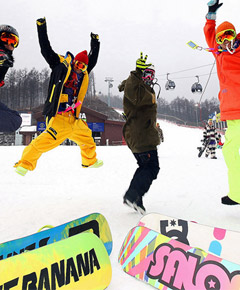Info Mongolia
Mongolia at glance
Area: 1,566,000 sq km (610,740 sq mi)
Population: 3.0 million (51% live in urban areas)
People: Khalkha Mongols (82%), Kazaks (4%), others (14%)
Regions: 21 Aimags (provinces). Aimags subdivided into Soums
Capital: Ulaanbaatar (47°55′N 106°53′E)
Languages: The official language, Mongolian, is spoken and understood throughout the country. Russian is the other major language used. However, other foreign languages, primarily English, are becoming more popular.
Religions: Buddhism (53%), Protestanism (40%), Shamanism (4%), Islam (3%)
Government: Parliamentary with a president elected every 4 years
Economy: Traditionally based on agriculture, livestock breeding (camels, bovine, goats, horses and sheep); mining (coal, gold, copper and uranium).
Time: GMT + 8
Electric current: 220 volts/50 HZ
Normal working hours: 09:00-13:00 and 14:00-18:00
Weight and measures: Metric System
Terrain: Mountains (40% of the territory) and rolling plateaus with vast semi-desert and desert plains in the center and desert zone in the south (Gobi)
Health: no specific requirements. Bring a basic medical kit and own medical supplies
People
The population of Mongolia is 3.0 million people. The urban population is approximately 1.7 million with the capital city, Ulaanbaatar, about 1.3 million inhabitants. While the average population density of Mongolia is just over 1 person per sq. km, About 75 per cent of the population of Mongolia speak Khalha Mongol, the official language, while another 15 per cent speak other Mongolian languages. Ethnic minorities are mainly speakers of Turkic languages, such as Kazakh, Tuvinian, Urianhai and Hoton.
Ethnic groups: 85% Mongol, mostly Khalkha Mongol. Also 7% Turkic (mainly Kazakh), 4.6% Tungusic and 3.4% other groups. Four million Mongols live outside Mongolia.
Geography
Mongolia is a huge, landlocked country about 3 times the size of France, squashed between China and Russia. At 1,564,116 km2 Mongolia is the world’s 19th-largest country. It was immeasurably bigger during the period of Mongol conquest under Genghis Khan and Kublai Khan. Until the 20th century Mongolia was twice its present size and included a large chunk of Siberia and Inner Mongolia (now controlled by China).
Mongolia has a 3,000km (1,864ml) border with the Russian Federation in the north and a 4,670km (2,901ml) border with China in the south. From north to south it can be divided into four areas: mountain, forest steppe, mountain steppe and, in the extreme south, semi-desert and desert (the latter being about 3% of the entire territory).
Culture
The Mongolian way of life is nomadic and intimately connected with the ways of animals. Despite urbanization, the traditions of the steppes live on. Even in the cities, the majority of Mongolians continue to live in a ger, a large, white felt tent that can be moved easily and has a universal layout: the door always faces south;
Mongolians have always taken wholeheartedly to Tibetan Buddhism and the links between Mongolia and Tibet are old and deep. Once in a lifetime, every devout Buddhist Mongolian tries to reach the holy city of Lhasa; the Tibetans in turn have relied on various Mongolian tribes to sustain their power.
Not until 1990 was freedom of religion restored. Since then, there’s been a phenomenal revival of Buddhism and other religions. Monasteries and temples always have Tibetan names. There’s a small minority of Sunni Muslims, about 5%, in the far western regions of Mongolia, most of whom are ethnic Kazaks.
Mongolia’s paintings, music and literature are dominated by Tibetan Buddhism and nomadism. Traditional music involves a wide range of instruments and singing styles. In Mongolian khoomi singing, carefully trained male voices produce harmonic overtones from deep in the throat called “throat singing”, releasing several notes at once. Traditional music and dance performances aren’t complete without a touch of contortionism, an ancient Mongolian tradition.
The Mongolians are big tea drinkers and the classic drink is suutei tsai (salty tea with milk). Herders make their own unique home brew airag, which is fermented horse’s milk with an alcoholic content of about 3%.
Climate
Known as “the land of blue sky”, Mongolia is a remarkable sunny country enjoying 250 sunny days a year. Mongolia has warm summers and extremely cold winters. The country has the world’s most typical continental climate with extreme diurnal and annual ranges of temperature. Average temperature in most of the country is below the freezing point from November to March and close to it in April and October. Winter nights of -40C occur most years (lowest recorded -55C at Lake Uvs). Summer extremes reach as high as +40C in the Gobi Desert and +33C in Ulaanbaatar.
Monthly temperature variations of +45C to -55C are not uncommon in many regions of Mongolia.
- Average summer temperature: +20C (+65F)
- Average winter temperature: -24C (-13F)
- Average precipitation: 25.4 cm
The History
Mongolia has a long prehistory and a most remarkable history. The prehistory started Huns, a people who lived In Central Asia from 3rd to the 1st century BC. The United Mongolian Great Empire was declared by Chinggis Khan in the early 13th century and his successors controlled a vast empire that included of China, Russia, Central Asia and the Middle East. The Mongolian Great Empire eventually collapsed and split up, and from 1691 northern Mongolia was colonized By Qing/Manchu/ China. In 1911 after Qing rule collapsed, the Bogd Gegeen Javzandamba- Mongolia’s religious leader was proclaimed Bogd Khan which was head of state. He declared Mongolia’s independence, but only autonomy under China’s suzerainty was achieved.
From 1919, nationalist revolutionaries, with Soviet assistance, drove out Chinese troops attempting to reoccupy Mongolia, and in 1921 they expelled the invading White Russian cavalry. July 11, 1921, then became celebrated as the anniversary of the revolution.
The Mongolian People’s Republic was proclaimed in November 1924, and the Mongolian capital, centered on the main monastery of the Bogd Gegeen, was renamed Ulaanbaatar (“Red Hero”).Mongolia was a one-party state closely tied to the Soviet Union from 1921 until end of the 1990. During that time Mongolia received technical, economic, and military assistance from The Soviet Union and generally followed Soviet guidance in political and economic matters in the building of a socialist society. Beginning of 1990, monopoly of political power was ended by the communists in favor of free multiparty elections, coalition government, and new constitution, greater cultural and religious freedom with more emphasis on Mongol national traditions, a neutral position in international relations, and a transition to a market economy.
The Flora & Fauna
Various Flora
Mongolian vast territory hosts several kinds of ecosystems. Forests consist primarily of pines and birches. They also shelter berry bushes and shrubs like the blueberry and blackcurrant trees and the potentille. Steppes and meadows hold graminaceous and wild wormwoods. Steppes blossom in spring and to a lesser extent in summer with myriad flowers such as edelweiss, gentians, geraniums, eyelets, delphiniums, peas, ancolies, rhododendrons, asters transforming Mongolia into an infinite garden. Deserts (including the Gobi) and semi-deserts are covered with sparse vegetation comprised mainly of saxauls and thorny bushes without leaves and with very deep roots.
Rich Fauna
Apart from the domesticated animals, the most widespread mammal is the marmot. Foxes, rabbits, squirrels, jerboas and other badgers are also common in the steppe. Wolves are present everywhere on the territory. The possibility of seeing wolves in summer is rare like the chance to see other threatened species such as brown bear (much rarer Mazaalai, Gobi’s brown bear), lynx, Saïga antelope, black tailed gazelle, wild ass and wild camel, ibex and other Argali sheep. Snow leopards are still present in mountains. Takhi (or Przewalski) horses were successfully reintroduced to and are now galloping freely through their homeland.
The bird lovers will not be disappointed: Vultures, eagles, falcons, magpies, cranes, corbels and larks accompanied in summer by swans, geese, pelicans, herons, ducks and 457 species of birds occupy the Mongolian sky. 75 species of fishes can be found in rivers and lakes.
The Natural contrasts
The Boundless Steppe
Prominent in Eastern Mongolia, the vast steppe is the region where Great Chinggis Khaan was born and is one of the most unspoiled and unexplored mysterious areas in Mongolia. Rich in places of historical, ethnographical, natural value, the Dornod Mongolian steppe is famous for its rare fauna and flora, and dramatic sunrises and sunsets. And the steppe is home to rich wildlife, especially thousands of white tailed gazelles and other species. Not only it holds one of the last great plain on earth, but it also allows you to feel a sensation of freedom while traveling through this human free boundless area.
The Great Gobi Desert
Gobi, one of the world’s most unusual deserts covers over 30 percent of the Mongolian territory, stretches for 3,000 miles along the border of Mongolia and China. The Gobi is home to many endemic animal species such as snow leopard, Gobi bear, wild mountain sheep (Argali), wild Horse (Takhi), Asian Wild Ass (Khulan), Wild Bactrian Camel (Khavtgai), Ibex (Yangir), black tailed antelope and gazelle. This is the area where Roy Chapman Andrews, the famous American paleontologist and his expedition, discovered the very first nest of dinosaur eggs on earth. Surprisingly, the harsh environment has produced the most resilient and remarkable people, who know every part of this desert in the back of their heads. Although now rare throughout the rest of the world, the two-humped Bactrian camel is common in Mongolia. This huge, yet gentle animal is the main source of milk and transport in the Gobi desert. The Mongolian Gobi consists of 33 different desert landscapes. Our tours in the lost country you will have a chance to ride through colorful valleys to the picturesque Khongor sand dunes, through rough but green saxaul forests to the ancient sea beds where dinosaur fossils were found by both local nomads and professional archeologists. But Gobi holds also many interesting places which are included in our tours, like Bayanzag and its “flaming cliffs”, Yol valley and its sheer rocky canyon, the oasis of Narandaats & Zulganai, and the mysterious land formations of Khermen Tsav, Ulaan Suvarga & Tsagaan Suvarga.
The Holy Altai Mountains
The snow-covered peaks of the Mongolian Altai Mountain Range rise up to 4400m above sea level and you will find here remote alpine lakes teeming with fish, ancient stone monuments, intricate rock paintings and ancient Turkish burial grounds, swift rivers, larch forests, and valleys strewn with wildflowers. The backcountry of western Mongolia is still relatively unexplored and offers spectacular scenery and excellent opportunities for traveling. Journeying through this region, you will discover the unique culture of the Kazakhs, Mongolia’s only Muslim minority. Many Kazakhs still hunt with trained eagles in the winter months and you will have an opportunity to see these magnificent birds during your travels.
The Khangai & Taiga
Located in the western half of Mongolia starting some 400 kilometres west – southwest of Ulaanbaatar, the Khangai are the country’s largest and third major mountain range after the Khentii and the Altai. Considered a transition zone from the Siberian taiga to steppe, the Khangai’s mountainous slopes are covered in thick forests, mostly larch, with a high diversity of other flora and fauna. The region’s lush, grass-covered valleys are fed by a multitude of streams, rivers and lakes. While travelling through this region you will explore bit of Switzerland where lush and serene vegetation and part of Siberia where winter is long and cold, with snow staying on the ground until May.
The Crystal Clear Lakes
Mongolia holds several magnificent lakes. Among them, the Blue Pearl of Mongolia Khuvsgul Lake, containing 2 % of the world’s fresh water, is sacred by locals as “Mother Sea”. Uvs Lake is itself the biggest lake of country, covering 3,350 km², though its salted water. And Terkhiin Tsagaan Lake formed by lava flows from a volcanic eruption. Those and the numerous other lakes hold variety of fishes and attract many species of water birds
The Protected Areas
Mongolians have a rich tradition to protect natural environment. Traditional nomadic life is based on the respect of nature. In 1778, the first protected area in the world was established in Mongolia. There are now 60 protected areas in Mongolia covering nearly 14% of the territory. Most of our tours are operated through those protected areas, since they contain many interesting sites. Then we can contribute to the protection of those areas by visiting them.
-
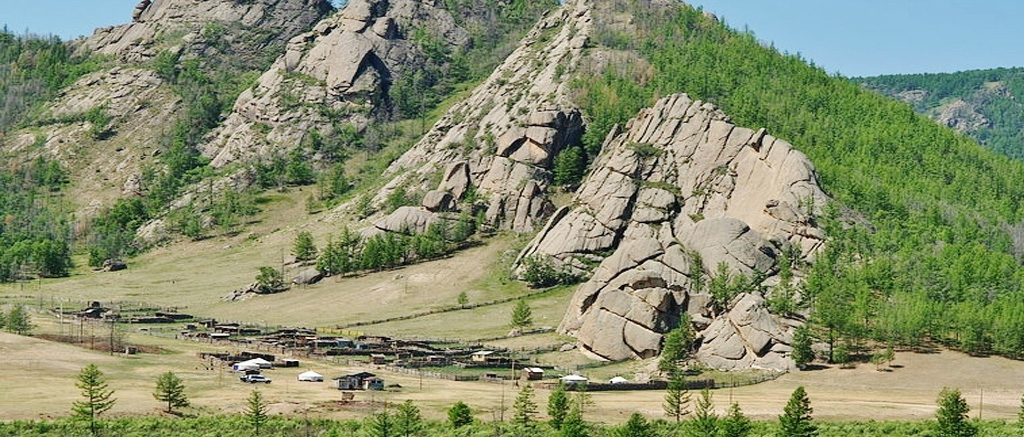 Terelj & Genghis Khan statue
Terelj & Genghis Khan statue
Price: 330 USD
2 day tour -
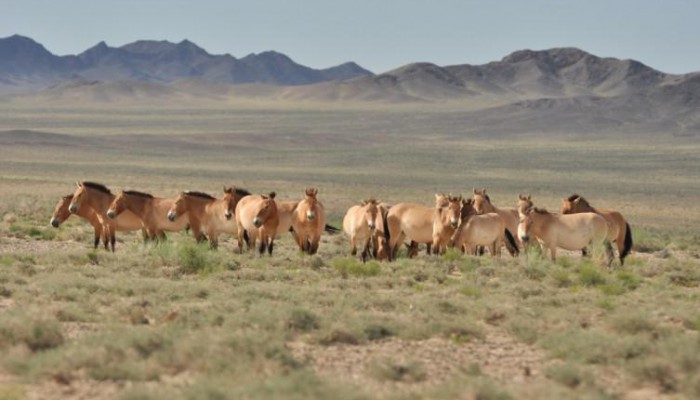 Karakorum & Hustai NP tour
Karakorum & Hustai NP tour
Price: 630 USD
3 full days -
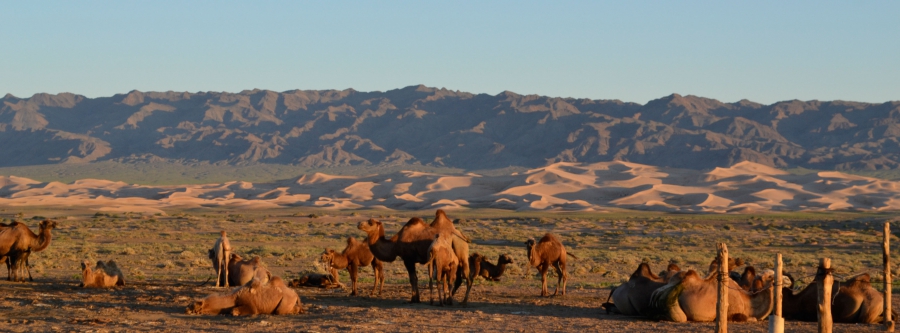 Treasures of Gobi & Khangai.
Treasures of Gobi & Khangai.
Price: 2780 USD
17 days -
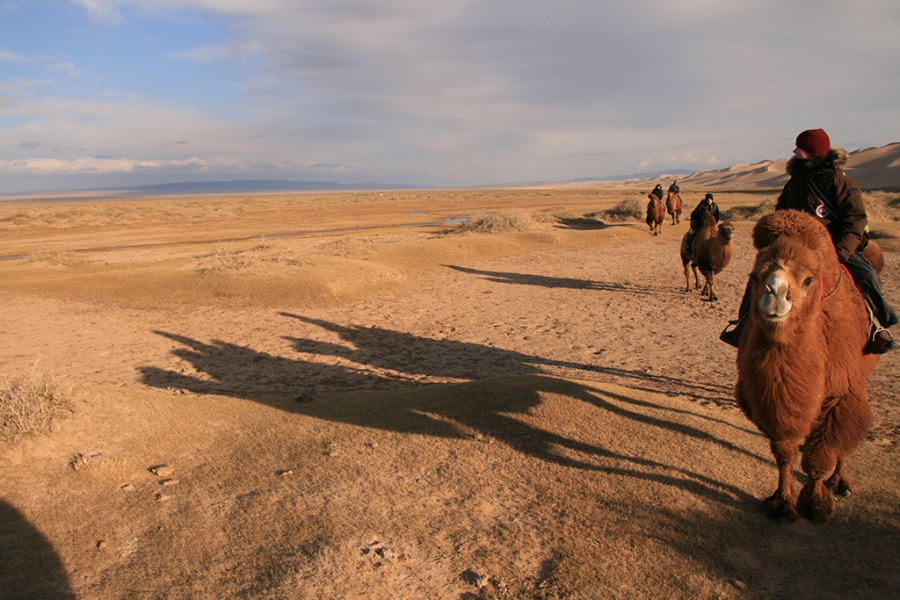 Gobi desert and Orkhon Waterfall
Gobi desert and Orkhon Waterfall
Price: 2230 USD
14 days -
 13th century & Terelj National Park.
13th century & Terelj National Park.
Price: 370 USD
2 day -
 Beauty of Northern Mongolia
Beauty of Northern Mongolia
Price: 1520 USD
8 full days -
 Bayanzag & Moltsog sand
Bayanzag & Moltsog sand
Price: 230 USD
1 full day -
 Mongolian lakes & Grassland
Mongolian lakes & Grassland
Price: 2300 USD
14 days -
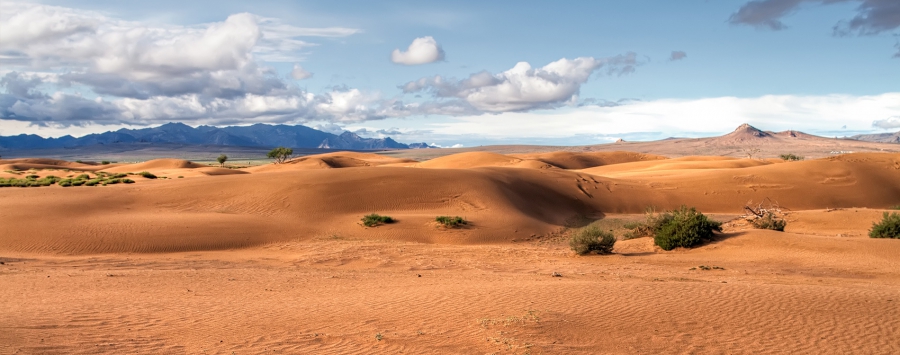 Gobi & ancient capital Mongolia
Gobi & ancient capital Mongolia
Price: 1780 USD
9 full days -
 Treasures of Gobi & Khangai
Treasures of Gobi & Khangai
Price: 2780 USD
17 days -
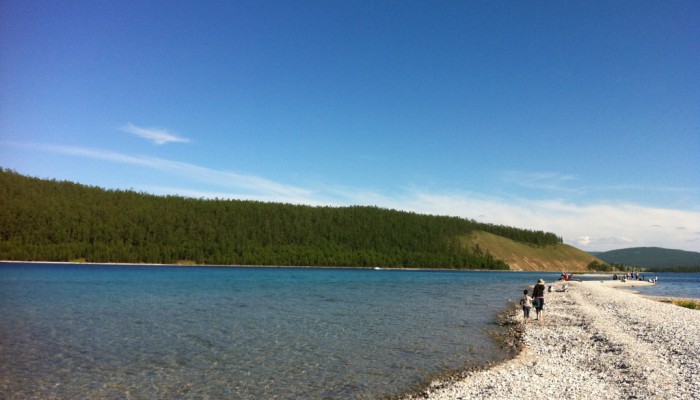 Mongolian lakes & Grassland
Mongolian lakes & Grassland
Price: 2230 USD
14 days -
 Gobi desert and Orkhon Waterfall
Gobi desert and Orkhon Waterfall
Price: 2229 USD
14 days
 EN
EN JP
JP RU
RU











